
The First and Only Weekly Online Fanzine Devoted to the Life and Works of Edgar Rice Burroughs |

The First and Only Weekly Online Fanzine Devoted to the Life and Works of Edgar Rice Burroughs |

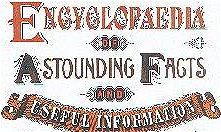
! ! ! IT'S HERE ! ! !
ORDER NOW
|
by Edgar Rice Burroughs |
This book collects in a single volume all of Edgar Rice Burroughs' non-Tarzan short stories and mystery puzzles, most of which have never before appeared in print with an introduction by Patrick H. Adams:
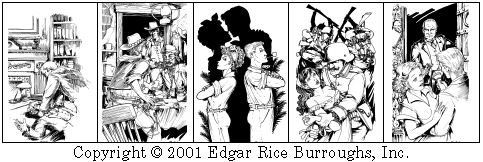
Publication of this 283-page book is scheduled for June, 2001. The print run will be small, based on the number of orders we have received by the time the presses are ready to roll, so it's important to order now to be sure of receiving a copy. Price is $49.95 plus shipping and handling.
About the Publishers
Guidry & Adkins, Publishers, was formed by two long-time Burroughs fans and collectors specifically to publish the previously uncollected works of Edgar Rice Burroughs. John H. Guidry is best known in fan circles as the founder of the Edgar Rice Burroughs Amateur Press Association (ERB-APA) and chairman of the 1988 World Science Fiction Convention in New Orleans. Patrick H. Adkins, editor of the Tarzana Project, is a professional editor and the author of several fantasy novels. Both have been active in Burroughs fandom since the early 1960s.To learn more about Edgar Rice Burroughs and his creations
(including books, movies, comics, and more), visit
The Dream Vaults of Opar
Drawing © 1915 Edgar Rice Burroughs.
All Rights Reserved. Used by Permission.
The Tarzana Project
Forgotten Tales! Brochure
CAUGHT IN OUR SITE
A sampling of ERB appearances on the Wild Wild Web ~ Sites worth a visit
Vintage Britannica | 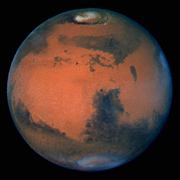
Britannica.com
June 29, 2000
The Allure of the Red Planet
Britannica.com delves into the pages of earlier print editions of Encyclopædia Britannica and comes up with oddities of all kinds—and more than a few gems. Here we offer a time-lapse view of our articles on Mars, with brief excerpts from various editions down through the years.Mars has long fascinated astronomers and others, and the findings that always inspire the most interest have been those suggesting that life either currently could exist or may have once existed on the red planet. Much attention, for example, has been given to NASA's recent announcement that there may be evidence of liquid water on Mars's surface. Encyclopædia Britannica has meticulously, but often skeptically, reported such findings through the years.
When reading the following selections, please note that the meanings and spellings of many words have changed over the course of time. But that's precisely what makes this journey so fascinating: the opportunity to observe such changes—as well as what stays the same.
From the first edition, 1771
The planet MARS is next in order [from the sun], being the first above the earth's orbit. His distance from the sun is computed to be 125 millions of miles; and by travelling at the rate of 47 thousand miles every hour...he goes round the sun in 686 of our days and 23 hours; which is the length of his year, and contains 667 3/4 of his days, every day and night together being 40 minutes longer than with us. His diameter is 4444 miles, and by his diurnal rotation the inhabitants about his equator are carried 556 miles every hour. His quantity of light and heat is equal but to one half of ours; and the sun appears but half as big to him as to us.
This planet being but a fifth part so big as the earth, if any moon attends him, she must be very small, and has not yet been discovered by our best telescopes. He is of a fiery red colour, and by his appulses to some of the fixed stars seems to be encompassed by a very gross atmosphere. He appears sometimes gibbous, but never horned; which both shews that his orbit includes the earth's within it, and that he shines not by his own light.
To Mars, our earth and moon appear like two moons, a bigger and a less, changing places with one another, and appearing sometimes horned, sometimes half or three quarters illuminated, but never full, nor at most above one quarter of a degree from each other, although they are 240 thousand miles asunder.
Our earth appears almost as big to Mars as Venus does to us, and at Mars it is never seen above 48 degrees from the sun; sometimes it appears to pass over the disk of the sun, and so do Mercury and Venus; but Mercury can never be seen from Mars by such eyes as ours, unassisted by proper instruments; and Venus will be as seldom seen as we see Mercury. Jupiter and Saturn are as visible to Mars as to us. His axis is perpendicular to the ecliptic, and his orbit is 2 degrees inclined to it.
From the third edition, 1797
These are the comments of Sir William Herschel, reproduced in the Encyclopædia.
"The analogy between Mars and the earth is perhaps by far the greatest in the whole solar system. Their diurnal motion is nearly the same; the obliquity of their respective ecliptics not very different: of all the superior planets, the distance of Mars from the sun is by far the nearest alike to that of the earth; nor will the length of the Martial year appear very differeut [sic] from what we enjoy, when compared to the surprising duration of the years of Jupiter, Saturn, and the Georgium Sidus [Uranus]. If then we find that the globe we inhabit has its polar region frozen and covered with mountains of ice and snow that only partly melt when alternately exposed to the sun, I may well be permitted to surmise, that the same causes may probably have the same effect on the globe of Mars; that the bright polar spots are owing to the vivid reflection of light from frozen regions; and that the reduction of those spots is to be ascribed to their being exposed to the sun."
From the fourth edition, 1810
MARS, in Astronomy, one of the eleven planets, situated without the earth's orbit, and remarkable for the extent of its sphere and the redness of its light....
(At that time, Neptune and Pluto had not yet been discovered, and four large asteroids were erroneously classified as planets.)
Now, the planet Mars is allowed to have an atmosphere of great density and extent, as is manifest from the dim appearance of the fixed stars that are placed at a considerable distance from his disk. The sun's light therefore, by which this planet is illuminated, having to pass twice through the atmosphere of Mars before it reaches the earth, must be deprived of a great ortion of the violet rays; and consequently the colour of the resulting light by which Mars is visible, must be red.
From the 10th edition, 1902
The earlier telescopic observers had no difficulty in discerning bright and obscure regions on the surface of Mars, and in luding from the varying aspects of these regions that it rotated on its axis in a period of a little more than twenty-four hours.... At the opposition of 1877, the planet was unusually near the earth; and although its south declination was not favourable to observations in the northern hemisphere, [Giovanni] Schiaparelli instituted a series of studies which, continued through several subsequent oppositions, have given rise to a large mass of literature on the subject. Observers had long seen, or fancied they could see, a remarkable resemblance between the surface of Mars and that of the earth. The brighter regions were supposed to be continents; the darker ones oceans. Schiaparelli's great discovery was that these supposed oceans were connected by omparatively narrow streaks, to which he applied the term channels (canale), a word which, through an unfortunate misconception, has been translated into English as "canal," thus giving rise to the impression that the features in question were the work of the inhabitants of Mars.
The studies of these features by other observers have been so numerous that it is impossible even to summarize them. Some have failed to see the channels at all, but the most successful in seeing and drawing them have been the observers at the Lowell Observatory. A careful comparison of the maps of Schiaparelli with each other, and with that of [Percival] Lowell, shows that there is by no means a complete agreement as to these features. Schiaparelli depicts them as rather obscure and more or less diffused bands or streaks of appreciable breadth, whereas in Lowell's drawings they appear as sharp, fine, dark lines.... The current interpretation of these features has been contested by [Edward Emerson] Barnard, who seems to have seen the planet under much more favourable conditions than either of the two other observers. He had the advantage of the great aperture of the Lick telescope.... In exceptionally favourable circumstances he could see markings so minute, intricate, and abundant that it was impossible to delineate them.... They were usually more or less irregular, consisting in delicate differences of shade. No straight and sharp lines were seen....
The apparent discrepancy can, we believe, be reconciled by some considerations on the psychology of vision. If we observe a stippled engraving of such an object as the human face from a certain distance, we see nothing but continuous light and shade. If we seek to draw what we see, we may form the best representation by lines representing the outlines of the human features. But if, instead of studying the engraving at a distance, we look at it through a magnifying glass, we see no lines whatever but only collections of points, perhaps without any well-defined arrangement, thicker in some regions than in others, and of various sizes. We thus learn that the eye possesses a property of representing collections and rows of points to the visual sense as continuous lines of light and shade. From this point of view it is quite natural that such features as those described by Barnard should, when seen with less sharpness, present to the eye the appearance shown on the maps of Schiaparelli....
Our general conclusions as to the physical condition of the surface of Mars may be summed up as follows: (1) The dark regions on the planet are not oceans, as was formerly supposed, the more probable hypothesis being that the dark colour is simply that of the solid surface of the planet. The amount of heat received from the sun on each unit of surface is less than half that received by the earth, and it is commonly supposed that the surface of our globe is, in the general average, warmer than it would be if our atmosphere were less dense or less rich in aqueous vapour. It is therefore very unlikely that the surface of Mars can be warm enough to allow of the presence of large bodies of water in the liquid state. (2) The so-called canals or channels are probably not the definite features that appear on the drawings, but rather the result of slight suggestions made to the eye by more or less irregular differences in the minute shadings and colour tints on the surface of the planet.
From the 13th edition, 1926
Seasonal changes of the surface markings are now conclusively established; a regular cycle of change with the Martian season is repeated at each opposition. The dark markings appear in regular succession, deepen in intensity and increase in area as the spring and summer advance, the polar snow melting meanwhile. It is difficult to resist the impression that we are viewing the annual growth of areas of vegetation on red desert soil. It is rash to accept so speculative a conclusion without more direct confirmation, but there seems to be no alternative explanation of the seasonal changes that is equally plausible. If life of any kind is admitted, can we restrict it to the vegetable kingdom? But that line of thought leads to guesses for which the astronomer accepts no responsibility.
From the 1973 edition
By careful preparation a man could undoubtedly survive on Mars. But he would be living in a hostile, alien environment where the slightest mishap could be disastrous. Atmospheric pressure at the surface appears to be much lower than was formerly supposed. To carry on respiration a pressure suit and oxygen equipment would be necessary. Many reactions so familiar to man on earth that they are taken as a matter of course would be impossible on Mars or would proceed very slowly. A man out on the open surface could not light his pipe or start a fire. Metal would not rust. Under the reduced pressure water would boil away so rapidly it would be useless for cooking purposes. None of the natural sources of energy, such as coal and oil, is available on Mars. Solar radiation would be weak and undependable. To establish a base on Mars, suitable nuclear reactors would first have to be developed to maintain it.
Because the Martian atmosphere is bombarded continually by the full flux of cosmic rays and full fluxes of solar flare particles, the radioactive products of the disintegrations present differ from those on earth and probably are somewhat more intense relative to the density of the atmosphere. The ultraviolet radiation penetrating to the surface also poses a hazard for man, and would require protective shielding.
Dreams of a Red Planet Reprint from Space.com
http://www.space.com/sciencefiction/mars_three_visions_991130.html
The Vanishing Martian
By Chris Aylott ~ Associate Editor
posted: 05:31 pm ET ~ 20 June 2000
No matter how many Pathfinder photos you've studied, there's still something about the image of green-skinned giants on thoats thundering silently across the mossy plains of Barsoom that whispers, "Mars."For that matter, a lot of people's mental maps of the Red Planet were shaped by tales of an ancient, golden-eyed race destroyed by chicken pox, looking benevolently on at the new species that replaces them. More recently, the story of a hundred human colonists divided by conflicting ideals of whether Mars should stay red or turn green has sparked our imaginations.
This trio of images spans nearly a full century, bookending science fiction from its beginnings as a genre to today.
Edgar Rice Burroughs started it with A Princess of Mars in 1912. Ray Bradbury began his Martian Chronicles in 1946, and Kim Stanley Robinson began his "Mars Trilogy" with Red Mars in 1993. Each of their visions of Mars is unique, and each defined Mars for the time and society in which they were written.
The differences in those visions have as much to do with the changing times in which they were written as our changing knowledge of Mars itself.
Welcome to Barsoom
Less than 15 years after H.G. Wells got science fiction's Martian ball rolling with The War of the Worlds, Edgar Rice Burroughs began expanding on Percival Lowell's theories about the Red Planet.
Peering up at the martian surface through a telescope, Lowell had seen lines he thought were grand canals, and attributed the work of cyclopean "architecture" to an alien civilization struggling to irrigate the planet's dry surface.
At the time, the idea received widespread scientific support, and was even considered "decisively" settled in Lowell's favor as late as 1915.
Burroughs ran with the idea, making his Mars -- called "Barsoom" by the natives -- a dying planet preserved by the efforts of a solar-powered pumping system that kept the atmosphere breathable. Martian cities were scattered along the waterways running toward the equator from the polar caps.
Barsoom was far from a desert world, however. Most of the dried-up seabeds were covered with a moss that fed herds of thoats -- giant beasts of burden -- and other animals. Giant trees lined the waterways, and the vegetation was similar to that found on Earth, only hardier and more garishly colored.
Red and green aliens
The Martians themselves were occasionally technically advanced and always socially primitive. At least in Princess of Mars, Burroughs' first Barsoom book, the dominant civilizations were the red men (near-humans with red skin) and the green men (15 feet tall with four arms and big tusks).The red men had advanced technology, but both races shared languages, tribal governments, and a violent attitude toward each other. They were honorable, but savage peoples.
This attitude was typical of Burroughs' era. In 1912, the Europeans and the Americans were enjoying the fruits of an age of colonization, having largely subjugated the native populations elsewhere. The natives of Africa and Asia -- to say nothing of the "red" natives of the Western Hemisphere -- were seen as little better than commodities, not humans to be dealt with as equals.
Of course Burroughs' audience would have expected John Carter to be smarter and tougher than the exotic aliens of Barsoom. He was, after all, an American among the natives.
Going to see the Martians
By 1946, Barsoom was no longer scientifically viable, and so was relegated to fantasy. Still, although Lowell's visions of canals were largely discredited, the idea retained enough resonance for Ray Bradbury to use them in his "Martian Chronicles" stories.Bradbury's Mars is almost as romantic as Burroughs', but the tone differs substantially. Thanks to the exotic science of the red martians, Barsoom managed to hold its ground against the forces of planetary entropy and extinction. With care and the help of a courageous earthling or two, the planet should sustain life for thousands of years to come.
On the other hand, Bradbury's Mars was truly dying even before the people of Earth inadvertently ended the Martian civilization. It was a desert planet, and the Fourth Expedition discovered that four-fifths of its cities had already been abandoned for thousands of years.
Still, a few Martians remained, to be glimpsed occasionally in the course of the stories -- it's significant that the only Martian to have an open and extended conversation with a human in the book is a ghost.
Bradbury's Martians are ancients passing on, not the friendly and unfriendly natives of Burroughs. The colonial era was ending when Bradbury wrote, and his Martians were vestiges of an archaic era, creatures to be recorded before they died out.
Stop all the clocks
The thread of mass extinction runs strongly through The Martian Chronicles, perhaps as a result of one of the other great changes separating Bradbury from Burroughs' era. Atomic destruction lurks in the background of the stories from the day after the Fourth Expedition sets foot on Mars.The humans bring universal death -- apocalyptic, atomic -- with them, first to the Martians and later to themselves.
Bradbury's Mars is a world in transition from the romantic fantasy of Burroughs to the more realistic Mars of later science fiction. It's not a transition Bradbury necessarily supports -- he is a poet and a romantic himself, and there is elegiac tone to his stories. The rebellious character Spender claims that "The Martians stopped where we should have, one hundred years ago," and Bradbury seems to agree.
Still, he's too honest a writer to turn the clock back on Mars.
The past is the past -- it sometimes talks to the present, but there is no returning to it. Bradbury looks forward instead, ending The Martian Chronicles with a new kind of Martian, human in form but willing to find a balance between the ways of Earth and Mars. Like Barsoom, the Mars of the Chronicles begins as a place to visit, but unlike Barsoom it ends as a lifetime home for humanity.
The human Mars
Contemporary science fiction doesn't have much room for native Martians. We know too much about Mars to people it with thoats and crystal cities.It's possible to find life there in current science fiction (Greg Benford comes up with a whole ecosystem in his recent The Martian Race) but current science forces those martian organisms to be so alien that humans can barely interact with them.
Today's SF Mars is a human world, driven by human conflicts, and right now the definitive statement on the subject is Kim Stanley Robinson's award-winning Mars Trilogy.
Red Mars, Green Mars and Blue Mars (along with a companion volume of related short stories called The Martians) trace the adventures of the first hundred humans to colonize Mars. There are about eight major characters, each representative of a central set of ambitions for the planet.
The major division is between the "reds," who wish to preserve Mars as it is, and the "greens," who want to terraform the planet into a new Earth. However, there are also conflicts between those who want or don't want independence from Earth, and those who support several different models of a Martian government.
Even with humans as sole occupants, Robinson's Mars maintains an alien mystery. Robinson went to extraordinary lengths to research the look and feel of living on Mars, even taking a trip to Antarctica to experience the earthly conditions that most resemble the Red Planet. In fact, this depth of knowledge led fellow SF writer William Gibson to characterize Robinson as able to "tell you everything about what it takes to terraform Mars."
As a result, Robinson describes the landscape so well that Mars itself becomes a character in the book. By understanding the landscape, you understand what drives each human character, and by understanding both landscape and the people inhabiting it, you can form your own opinions about the future of Mars.
It's too early to tell yet whether Robinson's vision will seep into the public consciousness the way Burroughs' and Bradbury's have. The Mars Trilogy is a dense, difficult work, much less accessible than Burroughs' action-packed adventures or Bradbury's dreams.
The first Martians
Red Mars and its sequels are being closely read by hard SF fans and science fiction writers, but the books may not spread much further -- except to one very important demographic group.The first settlers of Mars might well be alive today. They're going to be smart, capable people, dreamers with the incredible skills needed to win an alien frontier. Red Mars will be accessible to them because they will be living every day with the survival and colonization issues it raises.
It remains to be seen if Robinson's work will be hard science fiction to them. They may consider the books as fantastic as Barsoom, but there's still a real chance that they will carry the Mars Trilogy in them as their first planetary epic.
Fifty years from now, Red Mars might be considered a prototype of Martian literature.
MAILSTROM We receive a constant barrage of questions about ERB. Any information that our readers can share regarding the following queries would be most appreciated:
Bill:
I'm working on a book about advertising art from 1880-1930, and I'm trying to think of some landmarks to tie in to help illustrate the mindsets of the eras- For example, H.G. Wells published The Time Machine in 1898..And in the US, by 1909 there were almost 8,000 cars, but only ten miles of paved roads...
I was looking for SF in literature to show the "forward thinking" that didn't exist a decade earler (besides Verne), but any other tidbits are welcome...
Thanks,
Tom
CENTURY GUILD
I hope you can give me some help, or direct me to someone who can. I have just looked at your page. My husband dug out an old ERB-dom publication. It says its the tenth one...dated May, 1970. My husband was a member at one time.Regarding my question. He has a collection of juvenile books and we are trying find out something more about the Harry Prentice books because we have six or more of them. Our books are:
Captured by the Apes we have two. One with pictorial frontispiece and one without. Both say copyright by A. L. Burt. The one that has the pictorial frontispiece, the cover is green cloth, salmon colored border, has title on top in red lettering then a picture of boy in the lower left and an illustration on the lower right of the front cover. The spine has a title and the author's name in inlaid gold. Also has an illustration and the publishers name. I am thinking that is the one on your page.
The other book without the pictorial frontispiece has a tan fabric covered hard cover with red lettering on cover and spine.
Colored pictorial paste-on of 2 dogs and 2 hunters on the front cover. This book has two illustrations in it. One on page 71 is a picture of Phillip, panther and an animal just killed by panther. The other illustration is on page 261 and caption is the vast army of apes poured from the thicket attacking the party with great fury. Do you know the value both of these books ?The other books he has are:
Captured by the Zulus (2)
The Slate Picker
The Boy Explorers
I would like to know the value of all of them if you have any idea.
Thank you in advance for any help you can give me or pointing me in the right direction.
Carolyn/Tracy Catledge
Dear Mr. Hillman,My name is Kathy Monahan and I am the great, great, granddaughter of the late artist P.J. Monahan, who did a few paintings for the great Edgar Rice Burroughs. I have been looking for copies of magazine covers he did, and notice that you have quite a few on your web site. If possible, do you have any ideas on where I could look to find some of these magazines or perhaps the original oil paintings used for the magazines or book jackets. I do know that many of the originals were lost in a fire, but anything you could let me in on would be most appreciated
Thank you
Kathy
Do you have any idea how to reach a saint john decendent or to get more detailed records of his european exhibitions or his mothers...i also have info they might want.....also am interested in finding paintings.J. Hernstadt
Dear Bill Hillman,First, I hope my writing to you in this way is not an inconvenience. I am ying to get some information about an early Edgar Rice Burroughs publication that I own. I am thinking of selling it and wondering how to learn more about it and how to proceed. If this is not something you can help me with directly, perhaps you know of an internet site or forum where I can make some helpful contact. I`ve had trouble finding one.
Back in the `50`s, when I was a boy and reading Tarzan, I discovered a book in a Salt Lake City used book store that seemed exciting to me, so I saved up about $20 and bought it. (I don`t have the book here in front of me -- it`s in storage -- so the following description is from memory and could be innacurate in a detail or two.) The book is a privately bound collection of
All-Story magazines from 1912, 1913, and 1914, which include Tarzan of the Apes, Son of Tarzan, Beasts of Tarzan, and The Cave Girl, all by E.R.B., plus some Jack London stuff and more. But the Burroughs is the bulk of it. It`s my understanding that these are the very first publications of these novels. The sad thing, from a collector`s point of view, is that the margins of the magazines were trimmed down to fit the book binding -- so the magazines are not in pristine condition. Otherwise, so far as I remember, the condition is very good. When I say the page margins are trimmed, my memory is that no text or images were touched in the trimming, but maybe half an inch is taken off the top and bottom.As I said, I`ve reached a point where I`m thinking of selling `Just Tales` (the name the person had stamped on the spine), and I want to get an idea of how to go about it and what the book might be worth. I`d appreciate any thoughts or advice you may have.
Thank you,
Tim Rose
hi bill,
cool site of erb covers and info, i could spend days marveling at the great art. have a question about the story "Tarzan and the Jungle Queen", do you know if it was published in the Male Magazine July 1956? or if not that month, when? thanks
duane
MEMORABILIA GALLERY


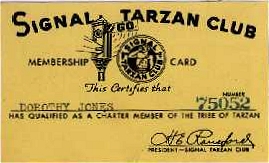
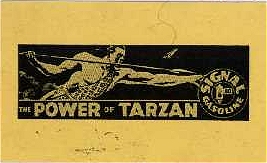
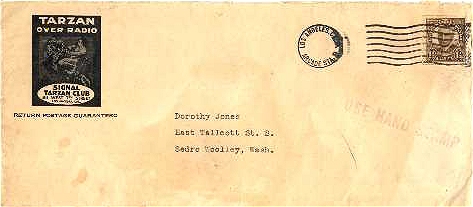

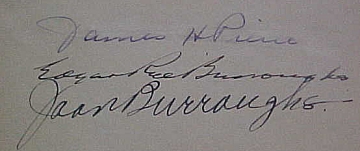
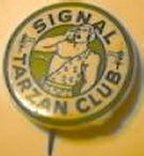
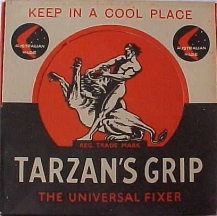
Tarzan's Grip Glue from Australia
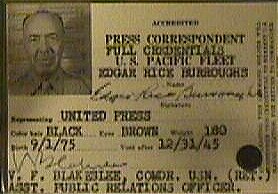

ERB ID Cards from the Louisville Collection
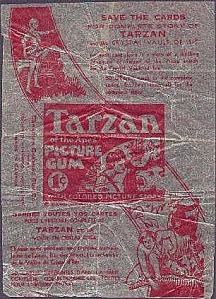
Crystal Gum Card Wrapper from
the Ron de Laat Collection
(Canadian Series)
Coming Soon
An ERBzin-e feature on these
cards


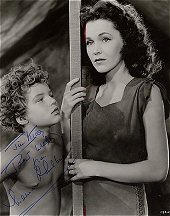


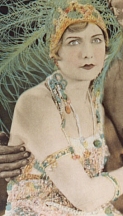
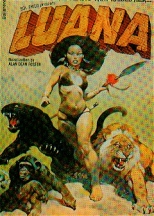
![]()
![]()
![]()
![]()
Volume
0558

BILL
HILLMAN
Visit
our thousands of other sites at:
BILL
AND SUE-ON HILLMAN ECLECTIC STUDIO
ERB
Text, ERB Images and Tarzan® are ©Edgar Rice Burroughs, Inc.-
All Rights Reserved.
All
Original Work ©1996-2001/2017 by Bill Hillman and/or Contributing
Authors/Owners
No
part of this web site may be reproduced without permission from the respective
owners.